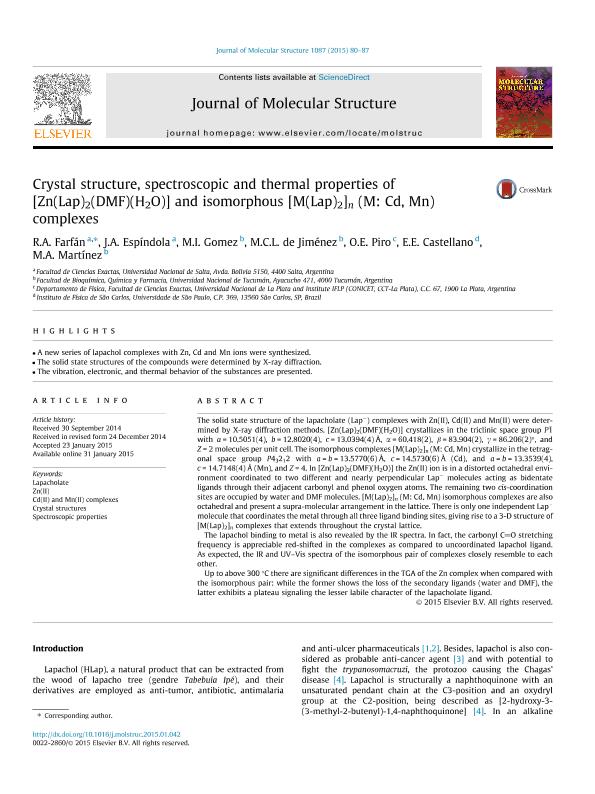Mostrar el registro sencillo del ítem
dc.contributor.author
Farfán, Ramón Antonio

dc.contributor.author
Espíndola, J. A.
dc.contributor.author
Gómez, María Inés

dc.contributor.author
De Jiménez, M. C .L.
dc.contributor.author
Piro, Oscar Enrique

dc.contributor.author
Castellano, E. E.
dc.contributor.author
Martínez, M. A.
dc.date.available
2018-03-05T17:45:25Z
dc.date.issued
2015-05
dc.identifier.citation
Farfán, Ramón Antonio; Espíndola, J. A.; Gómez, María Inés; De Jiménez, M. C .L.; Piro, Oscar Enrique; et al.; Crystal structure, spectroscopic and thermal properties of [Zn(Lap)2(DMF)(H2O)] and isomorphous [M(Lap)2]n (M: Cd, Mn) complexes; Elsevier Science; Journal of Molecular Structure; 1087; 5-2015; 80-87
dc.identifier.issn
0022-2860
dc.identifier.uri
http://hdl.handle.net/11336/37792
dc.description.abstract
The solid state structure of the lapacholate (Lap-) complexes with Zn(II), Cd(II) and Mn(II) were determined by X-ray diffraction methods. [Zn(Lap)2(DMF)(H2O)] crystallizes in the triclinic space group P1¯ with a = 10.5051(4), b = 12.8020(4), c = 13.0394(4) Å, α = 60.418(2), β = 83.904(2), γ = 86.206(2)°, and Z = 2 molecules per unit cell. The isomorphous complexes [M(Lap)2]n (M: Cd, Mn) crystallize in the tetragonal space group P43212 with a = b = 13.5770(6) Å, c = 14.5730(6) Å (Cd), and a = b = 13.3539(4), c = 14.7148(4) Å (Mn), and Z = 4. In [Zn(Lap)2(DMF)(H2O)] the Zn(II) ion is in a distorted octahedral environment coordinated to two different and nearly perpendicular Lap- molecules acting as bidentate ligands through their adjacent carbonyl and phenol oxygen atoms. The remaining two cis-coordination sites are occupied by water and DMF molecules. [M(Lap)2]n (M: Cd, Mn) isomorphous complexes are also octahedral and present a supra-molecular arrangement in the lattice. There is only one independent Lap- molecule that coordinates the metal through all three ligand binding sites, giving rise to a 3-D structure of [M(Lap)2]n complexes that extends throughout the crystal lattice. The lapachol binding to metal is also revealed by the IR spectra. In fact, the carbonyl CO stretching frequency is appreciable red-shifted in the complexes as compared to uncoordinated lapachol ligand. As expected, the IR and UV-Vis spectra of the isomorphous pair of complexes closely resemble to each other. Up to above 300 °C there are significant differences in the TGA of the Zn complex when compared with the isomorphous pair: while the former shows the loss of the secondary ligands (water and DMF), the latter exhibits a plateau signaling the lesser labile character of the lapacholate ligand.
dc.format
application/pdf
dc.language.iso
eng
dc.publisher
Elsevier Science

dc.rights
info:eu-repo/semantics/openAccess
dc.rights.uri
https://creativecommons.org/licenses/by-nc-sa/2.5/ar/
dc.subject
Cd(Ii) And Mn(Ii) Complexes
dc.subject
Crystal Structures
dc.subject
Lapacholate
dc.subject
Spectroscopic Properties
dc.subject
Zn(Ii)
dc.subject.classification
Astronomía

dc.subject.classification
Ciencias Físicas

dc.subject.classification
CIENCIAS NATURALES Y EXACTAS

dc.subject.classification
Otras Ciencias Químicas

dc.subject.classification
Ciencias Químicas

dc.subject.classification
CIENCIAS NATURALES Y EXACTAS

dc.subject.classification
Otras Ciencias Químicas

dc.subject.classification
Ciencias Químicas

dc.subject.classification
CIENCIAS NATURALES Y EXACTAS

dc.title
Crystal structure, spectroscopic and thermal properties of [Zn(Lap)2(DMF)(H2O)] and isomorphous [M(Lap)2]n (M: Cd, Mn) complexes
dc.type
info:eu-repo/semantics/article
dc.type
info:ar-repo/semantics/artículo
dc.type
info:eu-repo/semantics/publishedVersion
dc.date.updated
2018-03-02T14:08:38Z
dc.journal.volume
1087
dc.journal.pagination
80-87
dc.journal.pais
Países Bajos

dc.journal.ciudad
Amsterdam
dc.description.fil
Fil: Farfán, Ramón Antonio. Universidad Nacional de Salta; Argentina
dc.description.fil
Fil: Espíndola, J. A.. Universidad Nacional de Salta; Argentina
dc.description.fil
Fil: Gómez, María Inés. Universidad Nacional de Tucumán; Argentina
dc.description.fil
Fil: De Jiménez, M. C .L.. Universidad Nacional de Tucumán; Argentina
dc.description.fil
Fil: Piro, Oscar Enrique. Universidad Nacional de La Plata; Argentina. Consejo Nacional de Investigaciones Científicas y Técnicas. Centro Científico Tecnológico Conicet - La Plata. Instituto de Física La Plata. Universidad Nacional de La Plata. Facultad de Ciencias Exactas. Instituto de Física La Plata; Argentina
dc.description.fil
Fil: Castellano, E. E.. Universidade de Sao Paulo; Brasil
dc.description.fil
Fil: Martínez, M. A.. Universidad Nacional de Tucumán; Argentina
dc.journal.title
Journal of Molecular Structure

dc.relation.alternativeid
info:eu-repo/semantics/altIdentifier/url/https://www.sciencedirect.com/science/article/pii/S0022286015000617
dc.relation.alternativeid
info:eu-repo/semantics/altIdentifier/doi/http://dx.doi.org/10.1016/j.molstruc.2015.01.042
Archivos asociados
